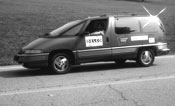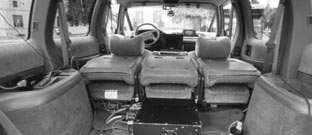2008 INDUCTEES
Raibert Hopper | NavLab 5 | LEGO® MINDSTORMS® | Lt. Cmdr. Data
NavLab 5

NavLab 5 was one of a series of autonomous vehicles developed at Carnegie Mellon. It looked much like a standard 1990 Pontiac TransSport minivan, but computers and video sensors made it capable of steering itself at legal speeds on everyday roads and highways.
In July 1995, research scientist Dean Pomerleau and robotics doctoral student Todd Jochem set out in NavLab5 to do something unprecedented: cross the country with a computer doing most of the steering. For the 3,000-mile “No Hands Across America” tour, Pomerleau and Jochem would operate the throttle and the brake and NavLab steered itself 98 percent of the time.
A video camera mounted just below the vehicle’s rearview mirror would read the road ahead, recognizing the lane it must follow by imaging lane markings, oil spots, curbs and ruts. The images would be processed by a portable UNIX computer workstation between NavLab 5’s front seats and appropriate instructions sent to an electric motor controlling the steering wheel.
“This was the first time that any autonomous vehicle had traversed so much different terrain,” said Robot Hall of Fame juror Chuck Thorpe, a NavLab pioneer who now is dean of Carnegie Mellon’s Qatar campus. “It’s not just a matter of purple mountains majesties – it’s a matter of painted lines on asphalt vs. reddish concrete vs. ‘Bott’s dots’ reflective markers in California, all of which make a big difference in how the road looks to a robot.”





